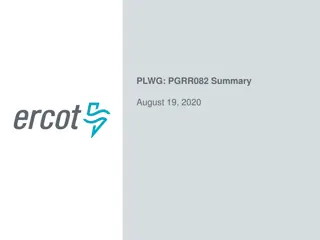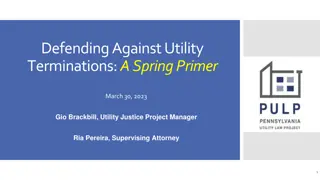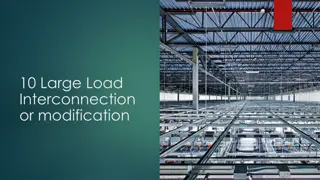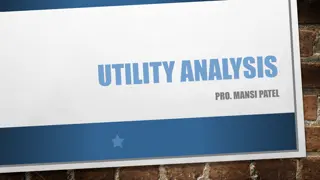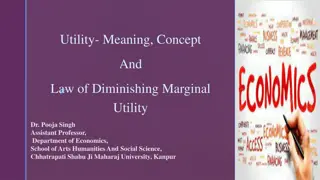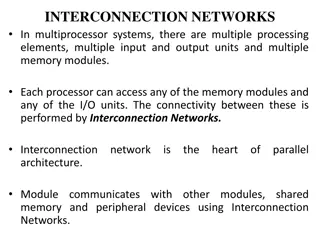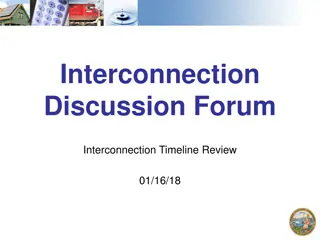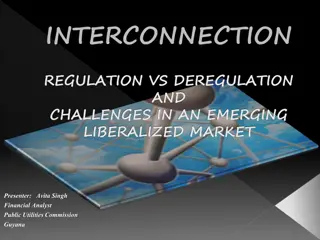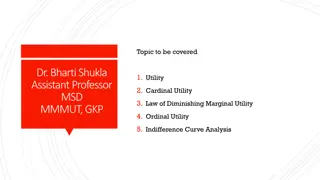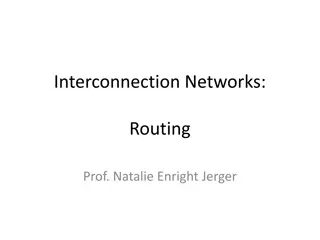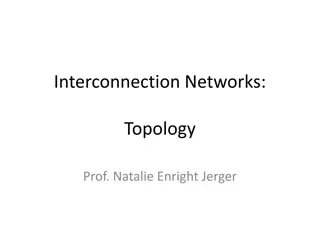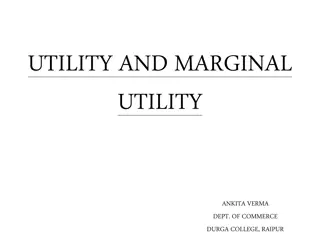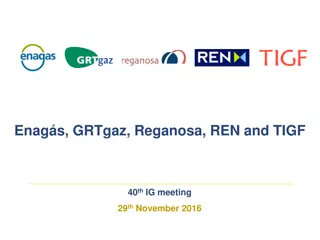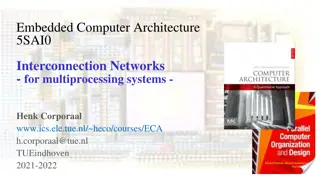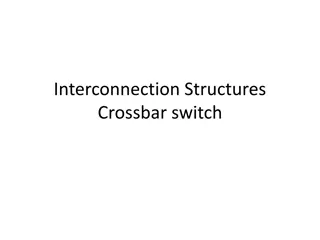Rules 2, 15, 16, and 21 in Utility Interconnection
This draft provides an overview of rules governing utility interconnection, focusing on Rules 2, 15, 16, and 21. It outlines meeting and learning objectives related to policy questions, mitigation costs, and interconnection timelines. Definitions of Line Extension (Rule 15) and Service Extension (Rule 16) are discussed, shedding light on distribution line and service panel extensions.
Download Presentation

Please find below an Image/Link to download the presentation.
The content on the website is provided AS IS for your information and personal use only. It may not be sold, licensed, or shared on other websites without obtaining consent from the author.If you encounter any issues during the download, it is possible that the publisher has removed the file from their server.
You are allowed to download the files provided on this website for personal or commercial use, subject to the condition that they are used lawfully. All files are the property of their respective owners.
The content on the website is provided AS IS for your information and personal use only. It may not be sold, licensed, or shared on other websites without obtaining consent from the author.
E N D
Presentation Transcript
Overview of Rules 2, 15, 16 and 21 DRAFT 5/11/2018 1
Meeting Objectives Provide education as precursor to discussing the scope item in OIR Capture key policy questions that may be considered in the OIR (not discuss solutions, but gain understanding of current gaps and challenges) Others? DRAFT 5/11/2018 2
Learning Objectives Understand when Rule 2, Rule 15/16, come into play in Rule 21 interconnection Understand the allocation of mitigation costs between the different Rules Understand if and how the different allocation affects the interconnection timeline to PTO and final cost calculation for OTCC and ITCC Understand the non-tariff policies of each utility to communicate timeline and cost expectations and manage to those expectations Others? DRAFT 5/11/2018 3
Basic Definition: Line Extension (Rule 15) Property Line Existing permanent distribution line Service panel Distribution Line Extension Service panel DISTRIBUTION LINE EXTENSION: (Rule 15) New distribution facilities of PG&E that is a continuation of, or branch from, the nearest available existing permanent Distribution Line (including any facility rearrangements and relocations necessary to accommodate the extension) to the point of connection of the last service. PG&E s Line Extension includes transmission underbuilds and converting an existing single phase line to three-phase in order to furnish three-phase service to an Applicant, but excludes transformers, meters and services.. DRAFT 5/11/2018 4
Basic Definition: Service Extension (Rule 16) overhead Service Extension Service Extension Service panel Service panel underground SERVICE EXTENSIONS: (from Rule 16) The overhead and underground primary or secondary facilities (including but not limited to PG&E- owned Service Facilities and Applicant owned service facilities) extending from the point of connection at the Distribution Line to the Service Delivery Point. When an underground Service Extension is supplied from a PG&E-designated overhead pole, the beginning point of connection to PG&E's Distribution Line shall be where the Service Extension is connected to PG&E's overhead Distribution Line conductors. DRAFT 5/11/2018 5
Allowances for Rule 15/16 PG&E will complete a Distribution Line / Service Extension without charge provided: PG&E s total estimated installed costs do not exceed the allowances from permanent, bonafide loads to be served Allowances are based on an average for Residential, but are calculated on a site-by-site basis for Non- residential customers. Rule 15.C.3/Rule 16.E RESIDENTIAL ALLOWANCES The allowance for Distribution Line Extensions, Service Extensions, or a combination thereof, for Permanent Residential Service is $2,154 per meter or residential dwelling unit. Rule 15.C.4/Rule 16.ENON-RESIDENTIAL ALLOWANCES The allowance for Distribution Line Extensions, Service Extensions, or a combination thereof, for Permanent Non-Residential Service is determined by PG&E using the formula in Section C.2. D07-07-019 -The monthly COO charge applicable to special facilities would be equal to one twelfth of the COS factor if the special facilities are utility financed and the utility pays for replacement over the same period.. The Cost-of-Ownership comes from the November 6, 2017 Advice Letter 3905-G/5176-E - In compliance with provisions of Gas Rule 2 and Electric Rule 2, PG&E submits this advice letter to revise its gas and electric distribution cost of ownership rates which apply to non-standard Special Facilities installed to serve specific customers. The cost of ownership rates are also used in determining, the residential gas and electric line extension allowances in Gas Rule 15.H.2 and Electric Rule 15.I.2. DRAFT 5/11/2018 6
Special Facilities: Definition Special Facility I. SPECIAL FACILITIES 1. PG&E normally installs only those standard facilities which it deems are necessary to provide regular service in accordance with the tariff schedules. Where the applicant requests PG&E to install special facilities and PG&E agrees to make such an installation, the additional costs thereof shall be borne by the applicant, including such continuing ownership costs as may be applicable. 2. Special facilities are: (a) facilities requested by an applicant which are in addition to or in substitution for standard facilities which PG&E would normally provide for delivery of service at one point, through one meter, at one voltage class under its tariff schedules, or (b)a pro rata portion of the facilities requested by an applicant, allocated for the sole use of such applicant, which would not normally be allocated for such sole use. Unless otherwise provided by PG&E's filed tariff schedules, special facilities will be installed, owned and maintained or allocated by PG&E as an accommodation to the applicant only if acceptable for operation by PG&E and the reliability of service to PG&E's other customers is not impaired. 7
Special Facilities: Definition Special Facilities (Rule 2) Unless otherwise provided by PG&E's filed tariff schedules, special facilities will be installed, owned and maintained or allocated by PG&E as an accommodation to the applicant only if acceptable for operation by PG&E and the reliability of service to PG&E's other customers is not impaired. Special Facilities can be assessed for: Generation Requests Demand Response Electric Vehicles Unique Customer Requests (i.e. dual service feeds) Special Program (e.g. Storage) DRAFT 5/11/2018 8
Examples of Standard and Special Facilities for LoadOnly (Non-Generation) Applications Standard Facility Special (or Added) Facility Service from a shared distribution line Single Service to a Premises Dedicated, express , feeder from PG&E substation Second Service to a Premises (above what is normally provided) Back-up Primary Line from the same or a Separate Circuit Primary Service from a Single Circuit 9 DRAFT 5/11/2018
Examples of Special Facilities for Generation Applications Net Generator Output Meters (as required by applicable tariffs e.g. NEMMT, NEMV, etc.) Telemetry (may be required under Rule 21) Direct Transfer Trip* (as determined by PG&E system protection) Transformer Upgrade** (incremental cost above loading requirement due to generator) * Two components of Direct Transfer Trip. Connection at PG&E s substation at transmission voltage is a network upgrade ** Net Energy Metering 1 MW or less has different treatment DRAFT 5/11/2018 10
Special Facilities: Components For PG&E, if customer requests, and PG&E agrees to the installation of non-standard or Special facilities, the customer pays the additional cost of these facilities. The costs are based on the: Cost difference between standard and special/added facilities. And also includes: Cost of ownership to cover PG&E s cost to own and maintain the special facilities. ITCC* per IRS Notices *Income Tax Component of Contribution DRAFT 5/11/2018 11
Generation (Rule 21/WDAT) Related Upgrades and Facilities Generation Projects can require upgrades and additional facilities to accommodate interconnection: These are defined as: Interconnection Facilities: sole use facilities that are required for a single generation interconnection Examples include an Net Generation Output Meter, dedicated transformer, etc. Distribution Upgrades: modifications to the Distribution System (<60KV) required for a single or cluster of generator interconnections Examples include reconductoring, a new substation bank, shared transformer, etc. Network Upgrades: modifications to the Transmission System (>60KV) required for a single or cluster of generator interconnections Examples include transmission protection equipment, transmission substation modification These upgrades are identified and included in the: - Interconnection Study Report - Generator Interconnection Agreement (GIA) or - Special Facilities Agreement (SFA), typically for Interconnection Facilities 12
Engineering, Procurement, and Construction of Facilities/Upgrades For PG&E, when projects require Interconnection Facilities or Distribution/Network Upgrades to interconnect, these projects follow a process to Engineer/Design, Procure, and Construct (EPC) the required work The EPC process applies to various types of work: PG&E internally generated projects customer building and renovation projects (e.g. New Business) emergency projects electric grid interconnection projects This EPC process has sometimes been referred to as the Service Planning or Rule 15/16 process. This is because historically, majority of customer driven work performed on PG&E s distribution system was for projects under Rule 15/16 More recently, this work relates to upgrades for Distributed Energy Resources interconnections 13
Possible Scenarios 1. New Generation Only ( Greenfield ) with No Load (e.g., NEMA, NEMV, NEMVMASH, RES-BCT, Wholesale) no Rule 15/16 contract Rule 21 Special Facility Contract Existing permanent distribution line Special Facility Interconnection Facilities DRAFT 5/11/2018 14
Possible Scenarios 2. New Load Service with New Generation Rule 15/16 contract and allowance eligibility reviewed for new load Rule 21 contracts cover facilities to accommodate generator interconnection (special facilities applies to all facilities required above Rule 16 service requirements) Existing permanent distribution line 15 DRAFT 5/11/2018
Possible Scenarios 3. Existing Load Service, Adding New Generation Service Panel Upgrade: Rule 15/16 contract and allowance eligibility review Rule 21 special facilities beyond what is required to serve Load No Service Panel Upgrade: Rule 21 only upgrades/additional facilities for generator as a special facility. Existing permanent distribution line PV AG Pumps DRAFT 5/11/2018 16
Possible Scenarios 4. Recent New Load Service, Adding New Generation Only Rule 21 contracts May be subject to deficiency bill per Rule 15/16 contract due to modified load demand DRAFT 5/11/2018 17
Questions Questions? DRAFT 5/11/2018 18
Key policy questions Should load and generation be considered together in how we calculate load Planning question look at this proliferation of solar differently in secondary (lots of solar in neighborhood) and primary distribution (one shopping center)? Should we be reviewing interconnection at a larger system level rather than individual services (IOUs have obligation to serve load in code) Cost responsibility assignment - ensure distribution allocation is accurate should there be an option for the customer to release the utility from the liability of obligation to serve. (note microgrid use case, large resource) NEM paired storage does not have a charging restriction and therefore max charging load is considered in studies the load side; should NEM paired storage follow the same rules as Rule 21 non-export Cost responsibility pertaining to design changes over time special facilities vs. standard facilities for upgrades; Is the service conductor a special facility if it is undersized as compared to service panel IOUs do not determine service panel size rather size to the load evaluation and size economically especially when undergrounding) Should there be consideration for old, unsafe service panel upgrades next to gas meters while the National Electrical Code requires it. 19
Key policy questions (cont) Should there be / what should the metric be for 1) assigning a project to an estimator/service planning 2) receiving an estimate 3) comparing the SIS timelines and cost (does the cost envelop option already handle this?) to actual and for: what types of upgrades (interconnection facility level, distribution level, and network level) for different parts of the process (design, estimating, construction) should it also contain a customer timeframe (there are already some of these in place), other factors (environmental permits, outage coordination with ISO) 4) How long voltage rise calculations should take?
Learning Objectives Understand when Rule 2, Rule 15/16, come into play in Rule 21 interconnection Understand the allocation of mitigation costs between the different Rules Understand if and how the different allocation affects the interconnection timeline to PTO and final cost calculation for OTCC and ITCC Understand the non-tariff policies of each utility to communicate timeline ad cost expectations and manage to those expectations Others? 21
Appendix DRAFT 5/11/2018 22
Rule 15 Overview Rule 15 covers the extension of Distribution Lines (less than 60kV) necessary to furnish Permanent electric service to Applicants Rule 15 covers the following: General Installation Responsibilities Distribution Line Extension Allowances Contributions or Advances By Applicants Refunds Applicant Design Option Applicant Installation Options Overhead Distribution Line Extensions for Subdivisions or Developments Special Conditions Definitions DRAFT 5/11/2018 23
Rule 16 Overview Rule 16 covers both (1) PG&E Service Facilities that extend from PG&E's Distribution Line facilities to the Service Delivery Point, and (2) service related equipment required of Applicant on Applicant's Premises to receive electric service Rule 16 covers the following: General Metering Facilities Service Extensions Responsibilities for New Service Extensions (Customer and PG&E responsibilities) Allowances and Payments by Applicant Existing Service Facilities Service Reinforcement Service Relocation or Rearrangement Impaired Access and Clearances Overhead to Underground Service Conversions (Rule 20 connection) Damaged Facilities Subdivision of Premises Exceptional Cases Definitions DRAFT 5/11/2018 24
Major Rule 15 Tariff Provisions: Cost Allocations Line Extension Cost Allocation Costs estimates are site specific Refundable portions of the line extension cost is reduced by Applicant s Allowances (load portion) Applicant s load (future revenues) and Refundable payments support the Line Extension Allowances Customer is granted a Customer/Meter Charge and Maximum Demand allowance Most all cases result in an allowance far less than the estimated cost to serve Allowances are not granted to off set any Special Facility DRAFT 5/11/2018 25
Major Rule 15 Tariff Provisions: Additional Info Project-specific costs/charges covered in Rule 15.D.2 Structured on cost causation principles Doesn t fully account for customer distributed generation Nearby Distribution interferes with pricing for Transmission line costs Special Facilities Facilities in an addition to or in substitution for standard facilities which PG&E would normally provide for Special Facilities are provided as an accommodation to the applicant only if acceptable for operation by PG&E and the reliability of service to PG&E s other customers is not impaired Additional reliability feature such as redundant feeds, non-preferred service options where it is less economical to provide than PG&E identified least-cost option DRAFT 5/11/2018 26
Rule 2 Overview Rule 2 is primarily on requirements for service connections with load. Rule 2 includes Special Facilities and ANSI requirements that relate to load and generation Rule 2 covers the following: General Service Delivery Voltages - includes description of distribution & transmission, single to three phase, and primary vs. secondary) Voltage and Frequency Control - American National Standard Institute (ANSI) requirements +/- 5% of nominal voltage General Load Limitations - Max Demand Load Permitted for various service types Protective Devices Applicant to protect its facility Interference with Service - Customer s obligation to maintain its electrical service to avoid interruption e.g. motor start current limits Power Factor - must provide equipment to not impact Power Factor Connected Load Ratings - description of how load is calculated Special Facilities (see next slide) Welder Service description of service for welding DRAFT 5/11/2018 27
Major Rule 15/16 Tariff Provisions: Customer Payments Payment Options for Rules 15, 16 Ten-year Agreement Refundable costs subject to refund for ten years Transmission customer may get refund each year for first three years based on demand increases or other Customers being served from same line extension in accordance with Rule 15. Cost of ownership charges deducted annually from un-refunded balance Customer may get deficiency bill if actual revenue doesn t meet the initial allowance granted 50% Non-refundable Discount Option Customer pays of the refundable costs above an allowance granted for Rule 15 extensions and Rule 16 Non-Residential extensions Customer not eligible for refunds Customer may get deficiency bill if actual revenue doesn t meet the initial allowance granted DRAFT 5/11/2018 28
Electric Forms related to Generation & Rules 2/15/16 Approved Rates for Cost of Ownership & ITCC Appendix A (Form 79-702), is utilizes specific Rates to determine costs. These are: 1. Cost of Ownership (COO) Rate (from Rule 2, Section I): 0.53% for Customer Financed and 1.22% for Company Financed. PG&E Advice Filing 3905-G approved by the CPUC 1/29/17 made effective 1/1/2018. Advice Filing 3905-G 2. Income Tax Component of Contribution (ITCC) Rate: The Current Rate is 24%. PG&E Advice Filing 3669-G/4766-E approved 2/11/16 and made effective 1/1/2015. Link 3. Present Worth Factor (PWF) Rate: Current Rate is 14.2%. PG&E Advice Filing 3896-G/5162-E approved 12/22/17 and made effective 1/1/18. Link DRAFT 5/11/2018 29
Electric Forms related to Generation & Rule 2/15/16 When Special Facilities are required for Generation, a Special Facility Agreement and its accompanying Appendix are executed with the Generation Customer: 1. Form 79-280 - Agreement For Installation or Allocation of Special Facilities for Parallel Operation of NonUtility-Owned Generation And/Or Electrical Standby Service (Electric Rules 2 and 21) Link 2. Form 79-702 - Agreement For Installation or Allocation of Special Facilities for Parallel Operation of NonUtility-Owned Generation And/Or Electrical Standby Service Appendix A Detail of Special Facilities ChargesLink DRAFT 5/11/2018 30
SFA Appendix A for Generation Project 24% ITCC (CAIC) DRAFT 5/11/2018 31
SFA Appendix A for Generation Project: Pg 2 Cost Of Owner- ship (COO) Facilities required and costs based on Interconnection Study Present Worth Factor (PWF) DRAFT 5/11/2018 32
Appendix IDF Timeline projects < 1 MW DRAFT 5/11/2018 33
INTERCONNECTION TIMELINE Timeline Assumptions: Rule 21 1MW Timelines given are based on average installer experiences. These are not guaranteed timelines given by any of the IOU s. Differing Procedures Between IOU s Interconnection Process Stages: 1. Application Submittal Process 2. Engineering 3. Design and Construction (projects with mitigations) 4. Special Facilities Agreements and Mitigation Payments 5. Commissioning 7
ENGINEERING REVIEW Engineering Timelines are all Rule 21 Tariff mandated and should be consistent between all IOU s Engineering Timeline Initial Review: 15 Business days Supplemental Review: 20 Business Days Supplemental Results Meeting: 10 Business Days Electrical Independence Test: 20 Business Days *System Impact Study: 60 Business Days SIS Results Meeting: 10 Business Days *Assumes project passes Screen Q and R in the EIT 9
DESIGN AND CONSTRUCTION (projects with mitigations) Timelines assume working CAD file and Spec Sheets at design initiation. SDG&E SCE PG&E Local Service planning design timelines differ depending upon the local offices queue. Design timelines can range from 60-180 business days. Construction typically ranges between 20-80 business days. SDG&E has stated that they have various timelines for their design process and construction process. The impute average design timeline used is 100 business days. The impute average construction timeline used is 60 business days. Design is typically 60 business days SCE has stated that they have a 90 business day construction timeline. Most installers experience a 60 business day construction timeline. Assumes no substation mitigations or Mini RTU s. Timeframes above indicate a range of some installer experiences. The handout timeline indicates a more average experience. 10
SPECIAL FACILITY AGREEMENTS AND PAYMENT PROCESSING SCE SDG&E PG&E Utilizes a payment advance method where a portion of the non binding costs are paid prior to design. Upon design completion SFA is drafted and remaining payment is collected. SFA drafting process is typically done in 5-10 business days. Prior to the start of design, the SFA is drafted. This process includes 15 BD for non-binding costs (unless DIS), 15 business days for a draft SFA and 15 business days for a final SFA. SCE requires full payment prior to start of design. Utilizes a payment advance method where a portion of the non binding costs are paid prior to design. Upon design completion SFA is drafted and remaining payment is collected. SFA drafting process is typically done in 5-10 business days. Assumes Projects <1MW 11
COMMISSIONING AND PTO PG&E SCE SDG&E Commissioning requests take about 5 BD to schedule. However, during a time of backlog, this can sometimes take 15 BD to schedule. Commissioning is typically scheduled for the following week. PTO is issued between 1-5 BD after the project passes the final inspection. Commissioning requests take about 5 BD to schedule. Commissioning is typically scheduled for the following week. It can sometimes take between 1-15 business days for PTO issuance as the project may be sent back to have a final review prior to PTO issuance. SDG&E s final inspections are initiated when the AHJ automatically uploads the final building permit (about 5BD). PTO is issued on the same day as the inspection is cleared by the on-site inspector. 12
Appendix IDF Timeline projects > 1 MW DRAFT 5/11/2018 40
WHAT ARE SOME TYPES OF MITIGATIONS? Key areas of concern COMMUNICATIONS Disconnect/Reconnect request/timing is different depending on what your purpose is (service planning vs. EGI approval) need variance approval and then Service Planning (Design & Estimating (NEM & NEMA) TYPES OF UTILITY MITIGATIONS: 1) Facility Upgrades 2) Distribution Upgrades 3) Network Facility Upgrades DISTRIBUTION AND NETWORK UPGRADES Telemetry Items always required for projects over 1MW Distribution Upgrades Typically Installed by Local Utility Estimating/Construction Group. Network Upgrades can be installed by local crews or specialized crews depending on the type of work required. Utility may use local crews or larger GC crews depending on the amount of work needed for the job. Larger crews may require more time for construction scheduling Timelines typically vary depending on the local office (PG&E: 4-10 months) (SCE: 5-8 months), (SDG&E: 6-8 months) Please refer to the utility unit cost guide for more cost clarification on upgrades costs. There are certain windows of time where upgrades can not be done e.g. ISO doesn t allow any facilities off line in the summer, bird season. CAN THESE WINDOWS BE PUBLISHED?
WHAT IS THE SUBSTATION UPGRADE PROCESS? SUBSTATION UPGRADES Typically assigned to a specialized group not the local office. Can be Distribution Upgrades or Network Upgrades Estimated Timeline: 12-24 Months Why do these upgrades have extended timelines? Complex Engineering and Designs: requires experienced specialized design and estimating. Permitting Process: Obtaining permits for these types of upgrades can be time consuming and sometimes require complex environmental permits. Procurement: challenging to procure the specialized equipment. Limited Resources: small selection of Contractors and utility crews that are certified to perform this type of work. Projects >1MW Rule 21 Section: Unspecified
Out of Rule 21 estimating timeline is not consistent: For small NEM projects SCE includes total cost estimate and must pay prior to moving to construction PG&E requires small engineering advance up front and includes combined block of time for design and estimating (24-34 weeks) then issued total cost Invoiced for SFA & Rule 15-16 then get on construction schedule For all IOUs, the system impact studies including non-binding cost estimate and timeline (SCE for non-NEM)
WHAT IS THE INTERCONNECTION FINANCIAL SECURITY PROCESS? Purpose: To ensure that the utility customer is capable of paying the interconnection costs. Different Types of Interconnection Financial Security (IFS): Letter of Credit Irrevocable Guaranty Cash Deposit in an interest bearing Escrow Account Fast Track Process Initial 30% Due 60 calendar days of IA Execution Remaining amount 20 calendar days prior to construction Start Detailed Study Process On or before start of construction FS 120 CD after FS 60 CD after SIS Start System Impact Study Construction 20% or $20K per MW 30% 100% Network Upgrades Process Utilizes a three phase step approach as well. Projects >1MW Rule 21 Section: F. 3. b. iv.
Questions for Interconnection Discussion Forum What is the definition and scope for each rule? When does Rule 2, Rule 15/16 tariffs apply in interconnecting DER under Rule 21 tariff (show on case study diagram for illustration? Projects have only Rule 21 Special Facilities Agreements issued when Projects have Rule 21 & Rule 15/16 when.. Projects have Rule 21 & Rule 15/16 & Rule 2 when When a project is triggered in Rule 21, what is the process to determine 1) the costs (estimating and design) and 2) the allocation between tariffs? What is the timeline for determining the mitigation cost and allocation across tariffs? Does the cost allocation to a specific tariff impact the timing? No specific timelines are articulated in Rule 2 or 15/16 tariffs IOU policy and procedures manage expectations for cost and timely execution by .<<how is this done?>> IOUs establish metrics for their service planning teams (what metrics/how is this done) Based on IOUs non-tariff policy what are the current timeline expectations for common mitigations? How does the tariff allocation (Rule 2, 15/16, 21) affect the final OTCC and ITCC Calculation? DRAFT 5/11/2018 46









